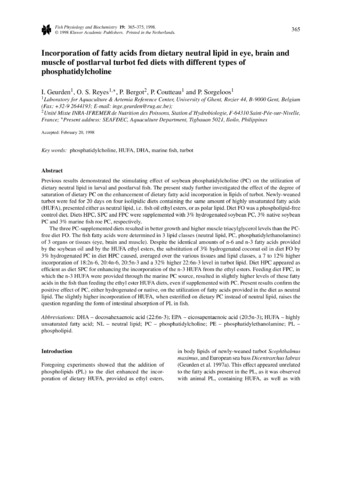Fatty acid composition of five candidate aquaculture species in Central Philippines
- Global styles
- MLA
- Vancouver
- Elsevier - Harvard
- APA
- Help

View/Open
Date
2004Page views
2,662ASFA keyword
AGROVOC keyword
Taxonomic term
Metadata
Show full item recordCited times in Scopus
92 readers on Mendeley
Share
Abstract
Fatty acid composition was determined in five candidate aquaculture species, mangrove red snapper (Lutjanus argentimaculatus), two rabbitfish (Siganus guttatus and S. canaliculatus), coral trout (Plectropomus leopardus) and striped jack (Caranx fulvoguttatus) sampled in the Central Philippines. Special attention was paid to arachidonic acid (ARA), eicosapentaenoic acid (EPA) and docosahexaenoic acid (DHA). Total lipids of hatchery-produced eggs and newly hatched larvae of mangrove red snapper unexpectedly had equal levels of ARA and EPA. Ovarian polar lipids were subsequently found to have intermediate or high ARA (5.5–10.7%) and DHA (14.4–20.4%) levels but relatively low EPA levels (1.5–1.9%), consequently showing high ARA/EPA (4.4–6.0) and DHA/EPA (7.4–14.9) ratios in wild mangrove red snapper and rabbitfish (S. guttatus and S. canaliculatus). Similar trends were observed even in hatchery-reared mangrove red snapper, rabbitfish (S. guttatus) and coral trout. Not only ovary but also liver and muscle contained relatively higher ARA compared with EPA in mangrove red snapper, regardless of the sample source. ARA, EPA and DHA levels in the polar lipids of wild fry (whole body) ranged respectively from 3.2% to 4.0%, from 2.7% to 4.7% and from 23.5% to 27.6% with intermediate or high ARA/EPA (0.8–1.5) and DHA/EPA (5.9–8.8) ratios in mangrove red snapper, rabbitfish (S. canaliculatus) and striped jack. As overall traits, the five species in the Central Philippines appear to have intermediate or high ARA and DHA levels with low EPA level, consequently having high ARA/EPA and DHA/EPA ratios compared to species in high and temperate northern hemisphere. Thus, the present results indicate that ARA is not a minor component in the tropical species, suggesting that ARA may be nutritionally much more important for egg development and larvae growth in the tropical species than in cold water species. The information of the present study can be used as a guideline for development of appropriate broodstock and/or larval diets in the Philippines.
Suggested Citation
Ogata, H. Y., Emata, A. C., Garibay, E. S., & Furuita, H. (2004). Fatty acid composition of five candidate aquaculture species in Central Philippines. Aquaculture , 236(1-4), 361-375. https://doi.org/10.1016/j.aquaculture.2003.10.015
Type
ArticleISSN
0044-8486Collections
- Journal Articles [1249]
Related items
Showing items related by title, author, creator and subject.
-
Advanced broodstock diets for the mangrove red snapper and a potential importance of arachidonic acid in eggs and fry
Emata, Arnil C.; Ogata, Hiroshi Y.; Garibay, Esteban S.; Furuita, Hirofumi (Springer Verlag, 2003)Mangrove red snapper fed advanced broodstock diets containing squid meal and squid oil exhibited higher hatching rates, cumulative survival and survival activity index than those fed a basal diet or a basal diet supplemented ... -
The essential fatty acid requirement of milkfish (Chanos chanos Forsskal)
Borlongan, Ilda G. (Springer Verlag, 1992)The essential fatty acid (EFA) requirement of milkfish was examined by a 12-week feeding trial using defined, purified diets at water temperature of 28–29°C and salinity of 32‰. The test diets contained varying levels of ... -
Incorporation of fatty acids from dietary neutral lipid in eye, brain and muscle of postlarval turbot fed diets with different types of phosphatidylcholine
Geurden, Inge ; Reyes, Ofelia S.; Bergot, Pierre; Coutteau, Peter; Sorgeloos, Patrick (Springer, 1998)
Previous results demonstrated the stimulating effect of soybean phosphatidylcholine (PC) on the utilization of dietary neutral lipid in larval and postlarval fish. The present study further investigated the effect of the ...
; Reyes, Ofelia S.; Bergot, Pierre; Coutteau, Peter; Sorgeloos, Patrick (Springer, 1998)
Previous results demonstrated the stimulating effect of soybean phosphatidylcholine (PC) on the utilization of dietary neutral lipid in larval and postlarval fish. The present study further investigated the effect of the ...





